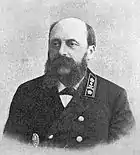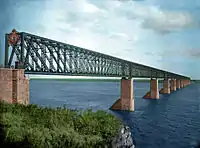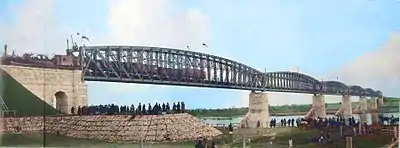Nikolai Beleloubski
Nikolay Apollonovich Belelyubsky (Russian: Белелюбский, Николай Аполлонович; 1 March [13 March New Style] 1845, Kharkiv – August 4, 1922, Petrograd) was a leading bridge designer, civil engineer and scientist in Imperial Russia.

Early life
Nikolay Belelyubsky was born on 1 (13) March 1845 in Kharkiv to a Russian noble family descended from the 16th century. He spent his childhood and youth in Taganrog and graduated with a gold medal from the Taganrog Boys Gymnasium in 1862. In that year he entered the Institute of Transport (today the St. Petersburg State Transport University, from which he was graduated in 1867.
Belelyubski was considered to be one of the Institute's greatest graduates, and after graduation he remained at the institute as a private tutor. In 1873 he was appointed Extraordinary Professor in the Department for Building Materials, and three years later he already held the position of Full Professor. He gained international recognition for his research and practice in the fields of bridge engineering and building materials.
In 1881 Belelyubsky was named a member of the Engineering Council of the Ministry of Transport Communications.[1]
Bridge builder
Belelyubsky personally designed and managed over 100 projects of long bridges. The total length of the bridges constructed upon his projects extended 17 kilometres (56,000 ft). These include the bridges over the rivers Don, Danube, Volga, Ob, Kama, Oka, Neva, Irtysh, Belaya, Ufa, Neman, Berezina, and many others.
In 1875 Belelyubsky designed the Alexander Railway Bridge in association with Vladimir Ilyich Berezin and Konstantin Yakovlevich Mikhailovsky. It was built on the Samara-Zlatoust Railway on the Volga near Syzran. Working on this project, Belelyubsky developed a method for analysis of waterway openings for large bridges, which later came to be widely acknowledged. Completed in 1880, this bridge was the longest in Europe with a total length of 1,483 metres (4,865 ft): its superstructure system had 13 spans, each 107 metres (351 ft) long. The bridge connected the railroad network in the central Russia with Volga region and, later, Siberia and Turkestan. The construction works involved approximately 2,500 thousand people, required more than 10 thousand cubic metres of masonries and approximately 6,5 tons of iron, and what is more, Belelyubsky personally obtained iron from Belgium, demanding metal of the highest quality. (In 2004, the original spans were replaced with contemporary ones.)


In the period from 1881 to 1884, a two-level rail bridge across the Dnieper in Ekaterinoslav was built under the supervision of Belelyubsky. The lower level was for trains only, while the upper level was designed for wagon traffic. The length of the bridge was 832 metres (2,730 ft). (The bridge was thoroughly renovated in the period of the 1930s to 1950s.)

While he was designing the rail bridges over the Volga river near Tver in 1885 and the Belaya River in Ufa in 1886, Belelyubsky developed and introduced a new technology: the transverse floor-beams were connected to the bottom chords of trusses by means of hinged "distance blocks". Such a type of structural support was considered to be ground-breaking in the days of Belelyubsky, as it allowed the reduction of secondary stresses in trusses. At the Edinburgh Exposition of 1890 this design received the gold medal and later came to be known abroad as the "Russian support method".[2][3]
From 1893 to 1897 Belelyubsky was in charge of constructing of the railway bridge across the Ob River near Novonikolaevsky (now Novosibirsk). It was the first of the grand bridges of the Great Siberian Way, connecting the two largest segments of the Trans-Siberian Railway ― the West Siberian and Middle Siberian railways. The bridge was for the first time equipped with spans which were topped by metal structures of the cantilever-beam type, while the bridge itself was the largest structure of the West Siberian Railway. The bridge commission headed by Belelyubsky tested the bridge on 28 March (9 April) 1897 by placing 4 locomotives, each of 51.5 tons, simultaneously on the structure. The bridge was opened for service on 5 (17) April 1897[4][5]
The apogee of his engineering career was the Romanovsky rail bridge, which was built in 1909-1913 across the Volga river near Zelenodolsk; It was renamed Red Bridge after the October revolution of 1917. Its oval openwork lattice spans amounted to 160 metres (520 ft) (a similar model was replicated for the bridge in Simbirsk). Due to their extension, the designer was able to reduce the number of spans (six large and two small). It was opened for traffic on July 11, 1913, and has served the people well. (In the period 2006-2011, the original spans were replaced with new structures.)
His last major project was the Don Bridge at Rostov-on-Don, built in 1912-1917, which he designed in association with G.P. Peredery and S. Belzetsky.[6]
Belelyubsky developed a method to build caissons in the construction of bridge piers, which later came to be called the "caisson-slipper" method. Additionally, he engaged in tests of building materials, especially reinforced concrete.[7]
Belelyubsky tried to help Russian science move forward, representing his country at many international railway exhibitions and forums. His bridge models were exhibited at several world expositions, including Paris in 1878, 1889 and 1900, Edinburgh in 1890, and Chicago in 1893. He attained the Russian civil rank of Active State Councillor, and his international recognition included an honorary doctorate from the Technical University of Berlin in 1907, an honorary membership in the Arkitechten- und Ingenieur-Verein zu Berlin in 1909 and an honorary membership in the French Society of Civil Engineers.[8] He was also a member of the International Association of Railroad Congresses and an honorary member of the Institute of Concrete in England.
In St. Petersburg he lived for a number of years at 4 Serpukhovskaya Street, moving in 1910 to 14a Bronnitskaya Street.[9]
Nikolay Belelyubsky died on August 4, 1922 in Saint Petersburg, and was buried in the Novodevichy Cemetery.
According to the testimony of contemporaries, Belelyubsky was a man of high culture and internal content. Modesty, devotion and material unselfishness were main personality traits of the founder of the Russian school of bridge building and the "poet" of bridge engineering. Even so, the outstanding scientist was considered to be a poor and oddish man, according to the standards of the society he lived in. But Belelyubsky himself never suffered emotionally from this. He preferred spiritual values to material goods, while serving the people was the greatest happiness for him.
Bridges
- Alexandrovsky Bridge on the Volga at Syzran, 1876–80
- Dnieper Bridge at Ekaterinoslav (later Dniepropetrovsk, today Dnipro, 1882–84
- Volga Bridge at Tver, 1885–87
- Belaya Bridge at Ufa, 1886–88
- Irtysh Bridge at Omsk, 1893–96
- Ob Bridge near Novosibirsk, 1893–97
- American Bridge on the Neva, 1896–97
- Rusanovsky Bridge at Kiev, 1904-0
- Finland Bridge on the Neva, 1910–12
- Romanovsky Bridge at Zelenodolsk (collapsed during construction 22 November 1911), 1910–13
- Don Bridge at Rostov-on-Don, 1912–17
Education activities
Belelyubsky made substantial educational efforts to prepare specialists for the country's railway lines. In addition to the Institute of Transport, he also lectured at the Mining Institute, the Institute of Civil Engineers, the Imperial Academy of Arts and Women's Polytechnic courses. And his work "The Course of Structural Mechanics" (1885) became the most popular textbook for students and a reference book for many engineers.
He used to tell his students:
"You are future engineers. What could be better? You will design and build bridges. Bridges are built to last for a hundred years or more. Look for the best designs, techniques and construction methods. But don't forget one thing: you must be the masters of your own construction projects. Not owners, but masters, as you build for the state, for the people. Build efficiently, carefully, sparingly, firmly, and originally. Every epoch brings its useful novelty, each engineer has to take a step forward in his practice. Anyway, he must want to do it, otherwise he is not an engineer, not the master of his own craft".
It is notable that under his leadership the "Society of Academic Support for Weak Students" and "Society on Fund raising for technical learning for women" were established.
See also
References
Notes
- St. Petersburg Encyclopedia (online), entry "Belelyubsky N.A." http://www.encspb.ru/object/2804012606?lc=en
- Civil engineers of the Great Siberian railway". http://archive.yourmuseum.ru/project/sib-foto/transsib/prolet/ingq.htm
- "Юрлов Н.165 лет со дня рождения Н.А.Белелюбского (1845–1922). Инженер, ученый, патриот // Наша школа. - №2(111). - 2010. - С.41" (PDF). Archived from the original (PDF) on 2016-03-04. Retrieved 2014-02-11.
- "Construction of railway bridge across Ob River". http://archive.yourmuseum.ru/project/sib-foto/transsib/prolet/obmq.htm
- "West Siberian Railways". eng.rzd.ru/statice/public/en?STRUCTURE_ID=4332&layer_id=4516&refererLayerId=4516&id=2550
- "North Caucasus Railways". http://eng.rzd.ru/statice/public/en?STRUCTURE_ID=4332&layer_id=4516&refererLayerId=4516&id=2560
- The Middle Siberian Railway was crossed by a ferroconcrete bridge at the 1919-verst mark. http://archive.yourmuseum.ru/project/sib-foto/transsib/railway2q.htm
- "Civil engineers of the Great Siberian railway", op. cit.
- St. Petersburg Encyclopedia (online), entry "Belelyubsky N.A.", op. cit.
External links
- "Civil engineers of the Great Siberian railway". http://archive.yourmuseum.ru/project/sib-foto/transsib/prolet/ingq.htm
- "Construction of railkway bridge across the Ob River". http://archive.yourmuseum.ru/project/sib-foto/transsib/prolet/obmq.htm
- "North Caucasus Railways". http://eng.rzd.ru/statice/public/en?STRUCTURE_ID=4332&layer_id=4516&refererLayerId=4516&id=2560
- St. Petersburg Encyclopedia (online), entry "Beleyubsky N.A." http://www.encspb.ru/object/2804012606?lc=en
- "Transsib Persons". http://old.transsib.ru/Eng/gal-men.htm
- "The Trans-Siberian Route," Wonders of World Engineering, Part 15 (8 June 1937) and Part 16 (15 June 1937). http://wondersofworldengineering.com/trans-siberian-railway.html
- "West Siberian Railways". http://eng.rzd.ru/statice/public/en?STRUCTURE_ID=4332&layer_id=4516&refererLayerId=4516&id=2550
- «Поселок Новониколаевский». http://prometeus.nsc.ru/gorod/history/100let-2ssi (in Russian)